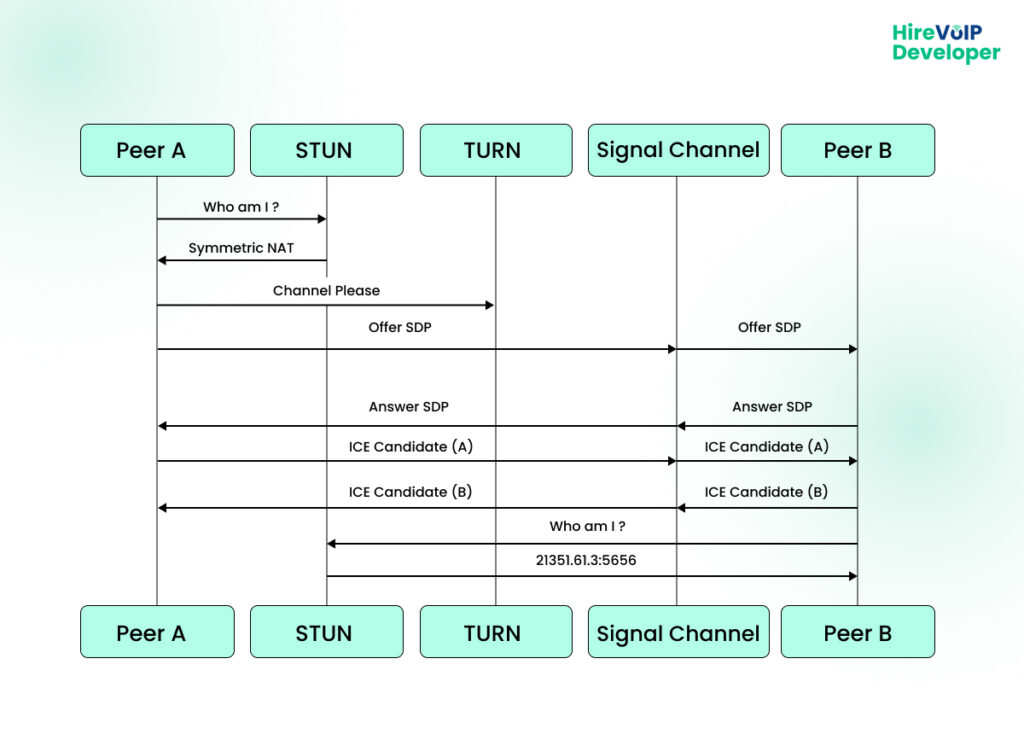Quick Summary—This is a quick guide to WebRTC that covers its definition, architecture, features, and use cases, along with key differences between WebRTC and WebSockets. You will also explore security aspects and how optimizing Kamailio can enhance WEbRTC performance.
Have you ever wondered how video calls, live streams, and online chats work seamlessly without needing third-party plugins? That’s WebRTC in action!
If you are a business owner, understanding WebRTC can help you unlock powerful real-time communication features. From WebRTC chat features to live streaming, its applications are endless. Let’s dive into a complete WebRTC overview, exploring its features, use cases, and architecture.
What is WebRTC?
WebRTC, or Web Real-Time Communication, is an open-source project that enables peer-to-peer audio, video, and data sharing in web browsers and mobile applications. Unlike traditional VoIP solutions, WebRTC eliminates the need for external software, making real-time communication faster and more accessible.
WebRTC & WebSockets
WebRTC and WebSockets both enable real-time communication, but they serve different purposes. WebRTC is designed for peer-to-peer video, audio, and data transfer, making it ideal for video calls and live streaming.
On the other hand, WebSockets excel at real-time messaging and bidirectional communication between a client and a server, often used for chat applications and notifications. If you need seamless media streaming, go for WebRTC. If you need persistent server-client communication, WebSockets is the better choice.
WebRTC Architecture – How it Works
To answer your question about how WebRTC works, at its core, the WebRTC protocol allows browsers and mobile apps to establish direct connections using WebRTC architecture. It utilizes the STUN, ICE, and TURN servers to handle NAT traversal and firewall restrictions.
Here’s how it functions –
- Media Capture & Encoding – WebRTC first captures audio and video streams from a user’s device, encoding them for efficient transmission.
- Signaling – Before peers can communicate, they exchange connection details using a signaling server (typically via WebSockets, SIP, or another protocol).
- NAT Traversal & Connection Establishment—Using the STUN, ICE, and TURN servers for WebRTC, navigates firewalls and NAT restrictions to create a direct peer-to-peer connection.
- Data Transmission—Once the connection is established, WebRTC securely transmits audio, video, and data using SRTP and DTLS encryption.
- Adaptive Streaming & Network Management – WebRTC dynamically adjusts the quality of media streams based on network conditions to ensure a smooth experience.

Features of WebRTC
WebRTC features make it a top choice for developers building interactive applications
- Real-Time Communication – Instant peer-to-peer connections.
- Cross-Platform Compatibility – Works on desktops, mobile devices, and browsers.
- Secure Connections – Uses DTLS and SRTP for encryption.
- Adaptive Bitrate Streaming – Optimizes media quality based on network conditions.
- WebRTC Data Channel – Facilitates secure file transfers and messaging.
With these WebRTC chat features, businesses can develop secure, high-performance communication platforms.
What is WebRTC Used For?
WebRTC use cases in our day-to-day life, including –
- Video Conferencing – Powering platforms like Google Meet and Zoom.
- Live Streaming—Social media giants are most likely to use live streaming apps using WebRTC for real-time broadcasts.
- Gaming – Enabling real-time communication in multiplayer games.
- Customer Support in call centers – Helping businesses offer live chat and call support.
- Healthcare & Telemedicine – Facilitating secure video consultations.
- IoT & Smart Devices – Enabling real-time device monitoring and control.
Whether for WebRTC chat features or large-scale streaming, WebRTC ensures smooth communication with minimal latency.
4 Aspects to Consider Before Hiring WebRTC Developers
No doubt, hiring a WebRTC developer seems like a daunting task! But before you dive in, consider these key aspects to ensure the right fit for your business.
- Experience with WebRTC Protocol – Ensure the developer understands WebRTC security, data channels, and architecture.
- Expertise in WebRTC Application Development – Look for hands-on experience developing WebRTC-based solutions.
- Understanding of WebRTC Security – Developers should implement encryption and secure signaling.
- Knowledge of WebRTC vs WebSockets – They should know when to use each technology based on project needs.
Glossary:
| Kamailio WebRTC Optimization:
Kamailio WebRTC optimization is a SIP server that can be optimized to enhance WebRTC performance. With proper configurations, Kamailio improves session handling, security, and call routing in WebRTC-based applications. |
Is WebRTC Secure?
While WebRTC offers low latency and efficient communication, several security concerns still need to be addressed.
Sensitive data, such as audio and video streams, must be protected from interception, eavesdropping, and unauthorized access. Additionally, WebRTC’s ability to bypass traditional network barriers, such as Network Address Translation (NAT) and firewalls, raises privacy risks, including the possibility of leaking real IP addresses even when a Virtual Private Network (VPN) is used.
Key WebRTC Security Features
To mitigate the threat risks, WebRTC has built-in security mechanisms; here is a glimpse into it –
- End-to-end encryption with DTLS and SRTP.
- Identity Verification to prevent unauthorized access.
- Secure Signaling Mechanisms to block potential exploits.
- Consent-Based Media Sharing for User Privacy.
- Protection Against Eavesdropping via Encrypted Data Channels.
WebRTC is secure when implemented with precision. With built-in features and measures like encryption, authentication, and secure transmission protocols, WebRTC security is at your fingertips.
Takeaway
WebRTC is a powerful tool that makes real-time communication effortless, secure, and widely accessible. Whether you’re a developer or a business looking to integrate WebRTC, understanding its security, use cases, and advantages can help you make the most of this powerful technology.
In summary, here is how our WebRTC solutions help you
- WebRTC simplifies real-time, peer-to-peer communication for video calls, live streaming, and messaging.
- It ensures high security with end-to-end encryption and secure authentication.
- WebRTC is plugin-free and cross-platform compatible, making it highly accessible.
- It outperforms WebSockets for media streaming, while WebSockets is better for persistent messaging.
Ready to explore WebRTC application development?
Start experimenting today with our WebRTC Solutions and unlock the full potential of WebRTC!



